Jessica Joslin’s Delightful Wunderkammer Creatures

Enzo & Donato (detail), 6″ x 6x 6″ each (12″ x 18″ x 10″-Mounted), 2004
Brass, bone, fur, cast/painted plastic, glass eyes
You may have already heard tell of Jessica Joslin‘s enchanted bestiary via the esteemed Wurzeltod, Brass Goggles or Boing Boing. If not, it’s a joy and an honor to introduce you to her work. In Jessica’s loving hands, delicate one-of-a-kind creatures are born of brass and bone, buttons and leather, glass eyes, mother of pearl, filigree, taxidermy, antique mechanical flotsam, scientific process, nostalgia and GENIUS!
From the Lisa Sette Gallery Newsletter:
Jessica Joslins’s odd menagerie begins with her penchant for collecting: “I find things anywhere that I find myself…in obscure junk shops, flea markets, attics, taxidermy supply houses, specialty hardware distributors… or walking through the woods.” Joslin seeks out and puts to use those bright odds and ends that might catch one’s eye in a box full of orphaned fixtures, or glinting up from the sidewalk. While each piece she employs in her eerie animal reliquary is delicately beautiful, it is also the detritus of human engineering and design: old brass buttons and gold braid, glass beads, clockwork cogs and velvet ribbon. Such items are reminiscent of the whimsical technology of a century past, one’s grandparents’ house, the dark interiors of old fashioned movie theatres – and as such they have an intriguing, wistful quality. In other words, Joslin collects the things that all of us secretly want to, the shiny pieces that we might comb through, handle and admire, but ultimately force ourselves to put down; what would we do with such things?
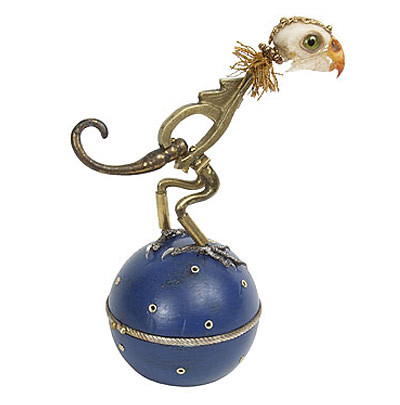
Flora, 4″ x 2″ x 3″, 2006
Brass, bone, sterling, painted wood, grommets, cast pewter, glass eyes
Jessica, who lives in Chicago with her commensurately brilliant husband, painter Jared Joslin, recently took time out of her busy schedule to answer several questions for the upcoming Coilhouse print magazine. You can read excerpts from this interview and meet a few more of her creatures under the cut. Also, anyone who happens to be in LA through the 23rd can take a closer look some of her work at the Los Angeles Art Show in Santa Monica.
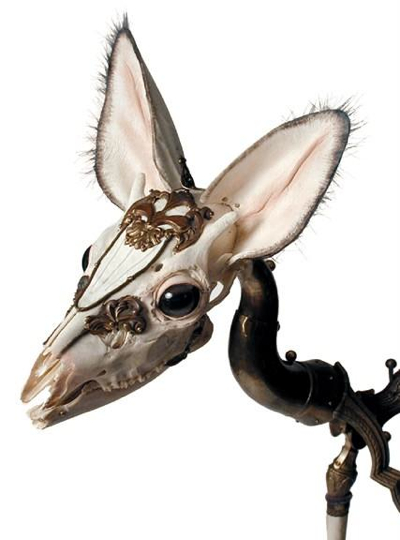
Helmut (detail), 36″ x 12 x 40″, 2005
Bone, brass, ball finials, leather, brass horn, velvet, glass eyes
CH: Your work seems to more readily inspire comparison to film, natural history, literature, architecture, fashion, or even music than to other mixed media art/sculpture. Perhaps because no one with knowledge of your work could mistake any given piece for something other than a Jessica Joslin original. What are some of the more interesting reactions/comparisons your decidedly singular art has engendered? Whose work has been especially inspiring to you?
JJ: Thank you! That is most lovely of you to say so! Hmmm. Honestly, I get quite a few letters from people who are excited to have found my work and say that it’s “just like” ______ (fill in the blank with anything that has bones in it). Some of the most flattering comparisons are Frederic Ruysch, Jan Švankmajer, The Brothers Quay, Pierre Jaquet-Droz’s automata, Lee Bontecou, Guiseppe Arcimboldo, Jeunet and Caro’s City of Lost Children, and Walton Ford.
I think that in a broad sense, I look at art that is very different from mine for inspiration. I take niblets of things from all over the place. I’m just as likely to use a detail from a couture gown as a bondage harness. I often look at the images of Albertus Seba, Jaap Best and Eadweard Muybridge when deciding what to make and my old Funk & Wagnalls’ wildlife encyclopedias are always at my fingertips. I have appropriated some bits from works by Helmut Newton (Helmut, 2005 was named after the late great man. The missing foot, replaced by a wheel, is a secret nod to one of my favorite series by him, of a woman wearing fetish heels in a wheelchair.) I also love the lush, stylized look of photographers like Eugenio Recuenco, Erwin Olaf, and Pierre et Gilles. Images and anecdotes of Barnum’s American Museum (1841 to 1865) have always set off many and varied sparks.
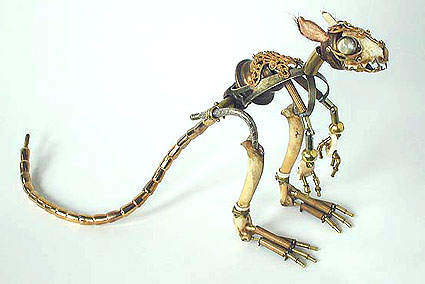
Scorel, 7″x6″x10″, 2003
Antique brass beads & findings, lobster forks, universal joints, bone, acrylic, sculpted/ painted leather
Lee Bontecou’s work really caught me off guard when I first saw it. I don’t know how to explain this without seeming presumptuous, but when I saw her work, it almost felt as if I were seeing something that I had made myself in another life or another dimension. Oh, that sounds so corny. It was very powerful experience though. I was skulking about the corners, trying to keep people from seeing my tears. Of course, the other Joslin artists, Jared as well as his brother Russell Joslin, a brilliant photographer, are a constant inspiration.
You’re a self-described “intrigued autodidact” with a solid background in biology and anatomy. How did you go about collecting your working knowledge of the inner workings of vertebrate life?
When I was little, I planned to become a biologist. When the non-nerds were going to summer camp, I spent my summers at the Acadia Institute of Oceanography, grooming myself my planned career path: going to MIT and then working at the Woods Hole Oceanographic Institution. I was about 9 or 10. The average age for the other kids was about 18 or so. (It was considered something impressive to put on a college application.) Anyway, it was amazing. I went there for several summers. We collected specimens, did core samples and dredged the bottom of the Atlantic, pulling up strange and beautiful fish with seaweed-like protrusions. We went deep-sea fishing and I caught a shark. We later realized that it was pregnant, and gave it an impromptu c-section. We kept the baby sharks (complete with dangling yolk sac placentas) in a tank in the lab until they could be released. This was in Maine, and I loved that there were more rocky cliffs than beaches (I’ve never been fond of the beach, except in wintertime.) I’d walk along the mist-coccooned craggy cliffs, which looked like something from Hitchcock’s Rebbecca, daydreaming about the past and the future.

Marco (detail), 9″x5″x9″, 2006
Antique hardware and findings, bone, beads, fur, painted wood,
satin and velvet collar, glove leather, glass eyes
From a very young age, I was unusually obsessed with the Natural History Museums at Harvard. I was always begging my Dad to bring us there again and again. I was utterly enraptured by the taxidermied animals and the incredible collection of Victorian articulated skeletons. It’s odd, but somehow I only recently realized that, in part, my fascination had to do with being very near-sighted. I didn’t realize that I needed glasses until I was almost 16. I could only see clearly a few feet away. When people said that they saw a bird in flight, I just saw a blurry smudge. To me, it was an intellectual connection I knew of them from books and museums. I got very good at recognizing shapes and movements. It didn’t occur to me that other people could see the bird clearly. The relevant part, in context of my work, is that the only wild animals that I saw for years really, were either taxidermied or in pictures. That is the way that I fell in love with the animal kingdom. I’ve spent many years living in books and museums.
One of the main buildings at the Chicago Art Institute is made of mirrored glass and there is a large fountain in front of it. All species of birds would end up in the pond, having crashed into the glass windows. I would wade in, collect the dead birds, and use them to practice taxidermy, which I learned from old manuals from the library. (Incidentally, that was how I met Jared. One day he said hello and we started talking about the birds floating in the fountain. We quickly realized that we both had freezers full of dead birds, so I offered to give him taxidermy lessons. The rest is history.) Anyway, I learned a great deal about anatomy from doing those bird dissections and from preparing their skins for mounting. I also spent a bit of time at the Field Museum of Natural History, repairing the dinosaur bones and sculpting replacements for missing parts. They have the most amazing collections, many of them behind the scenes:…rows upon rows of drawers filled with specimens and huge tanks of dermestid beetles for preparing skeletons. Once, Jared saw a huge pair of swans in the tanks. I always wished that I could have seen that.
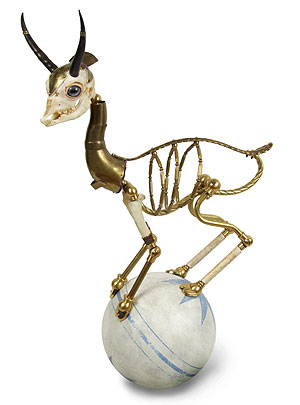
Marcel, 23″x8x15″, 2006
Antique hardware, brass, beads, horns, bone, shoe taps,
glove leather, steel, glass eyes
There are those who make art because they find it enjoyable or challenging, but most truly visionary artists seem to NEED to create to live a healthy life… it’s as important to them as breathing and sleeping. It seems likely that you are in the latter category. If so, was there ever a pivotal moment in your youth (or later, if that’s the case) when you realized that you needed to be an artist?
Yes, it was towards the beginning of high school. I took a photography class and it swept me off my feet. Science was my first great love, but art takes no prisoners! I never stood a chance. I think that what appealed to me most about the arts, photography in particular, was that it gave me the opportunity to be involved in scenarios that would never happen otherwise. I was 14, so I did the typical arty types of photo shoots…a person in a milk bath or covered with powder or in a funhouse mirror. I loved having an excuse to ask people to do these things…and I loved the magic of making the first contact prints and seeing what I had captured. I spent most of high school in the darkroom, learning techniques and honing my skills. I hardly saw the sun for all those years! I don’t know if I could pinpoint exactly what it is that still keeps me coming back for more, but I know that if I don’t work on art for awhile, I’m as twitchy and agitated as an addict needing a fix. I like the way that being an artist gives everything a subtext. I feel like I always have a secret agenda. It makes me take risks and put myself into situations that I otherwise wouldn’t. It gives me the confidence to throw myself into situations that I might not otherwise tackle. I love the challenge of learning new skills and discovering ways of integrating them into my personal work.
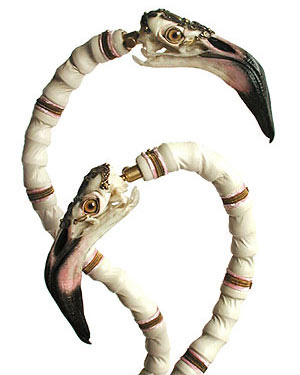
Candido & Caprice (detail), 2005
Brass, snakeskin, vestment trim, velvet, antique opera glove leather,
turtle shell, cast and painted plastic, glass eyes

January 22nd, 2008 at 11:52 pm
I was wondering when her critters were going to roll in here. Jessica Joslin rules…psyched this’ll be in the print mag!
January 22nd, 2008 at 11:58 pm
Hee. This post in particular is blatantly lacking journalistic impartiality. The Joslins are my absolute favorites. I can’t wait for Jessica’s book to come out!
January 23rd, 2008 at 7:29 am
Her work is AMAZING! Loved the interview as well . . .
January 23rd, 2008 at 12:14 pm
[…] judging by the amount of neat stuff she’s found to make her menagerie with. There’s an interview with her over at Coilhouse, which I’m not even going to bother excerpting, because you’re all […]
January 23rd, 2008 at 2:07 pm
Thanks for posting about all this wonderful artists in your blog! It is becoming such a treasure index.
January 23rd, 2008 at 2:56 pm
Thanks for reading, Mer! :)
January 23rd, 2008 at 7:23 pm
I accept everyone’s hatred for living 5 miles from this exhibit. Thanks for the notice, Mer.
January 24th, 2008 at 12:06 am
Ahhhh…thank you, thank you for that beauteous post Mer. You’re my favorite too! *wink* I’m honored to be in such marvelous company…every day, another of my favorite artists pops up on here!
book…is…very…close… *swoons with glee*
You are all so very kind. Schucks. I hope you enjoy visiting the cats, Brock!
January 24th, 2008 at 7:46 pm
The sweet poetry in finding mutual grounds in a freezer-ful of birds.
Lovely interview, thank you.
March 29th, 2008 at 6:14 pm
This is the first time I’ve seen her work. It is so exquisite! Her art is very much like her home city (Boston) – old blends together to form new, new and old meet to form something great.
Thank you for putting this up! I never would have found it, otherwise.